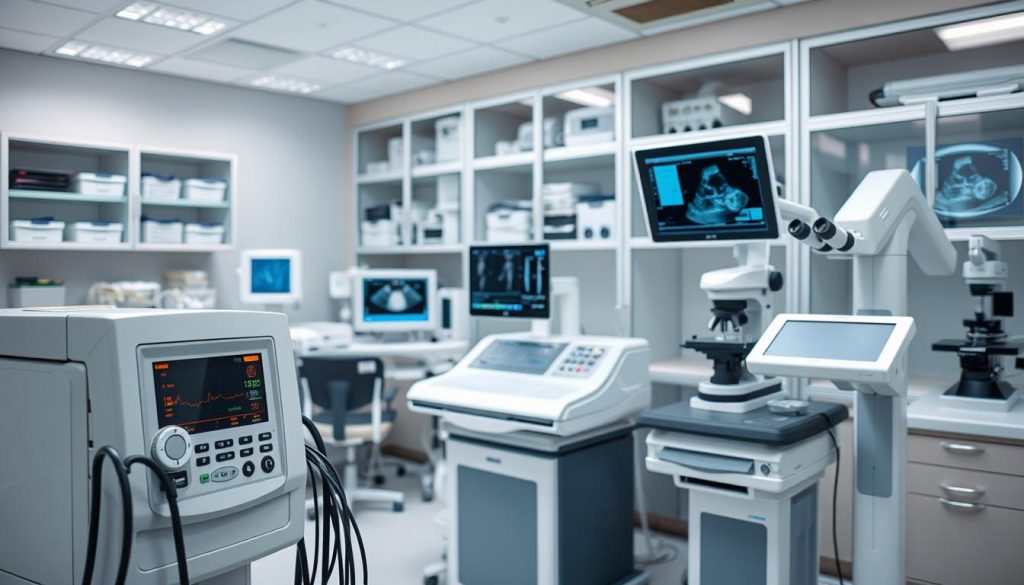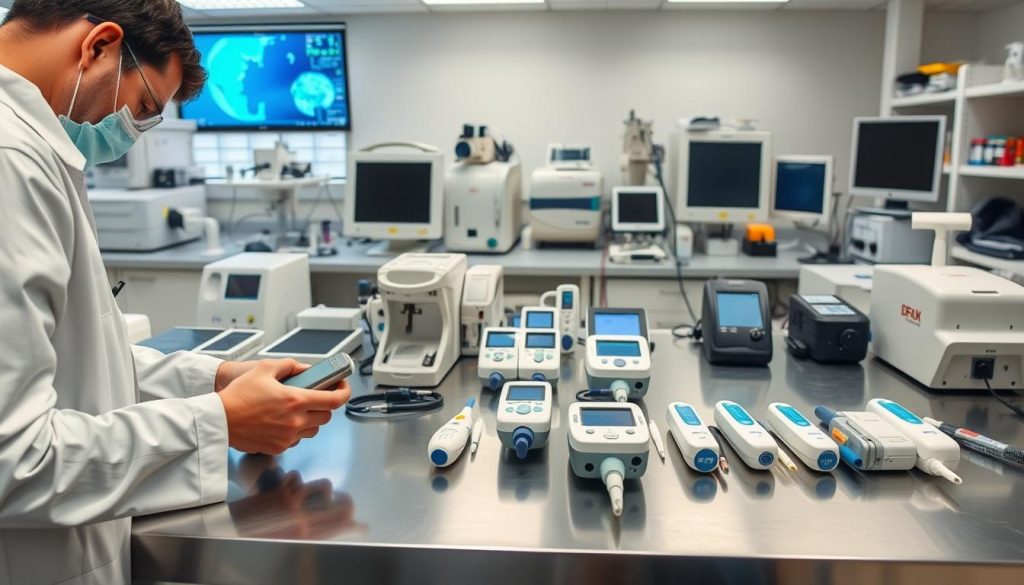Healthcare professionals and facility managers face critical decisions when selecting medical diagnostic tools. This guide helps navigate choices to improve patient care and efficiency. From imaging devices to lab analyzers, the right clinical diagnostic tools can transform outcomes. For personalized advice, contact Mr. Abdul Alim at +8801711994334.
Key Takeaways
- Select tools based on specific clinical needs.
- Accuracy and reliability are top priorities for medical diagnostic tools.
- Modern clinical diagnostic tools integrate with existing systems.
- Technology like AI improves diagnostic speed and precision.
- Consult experts like Mr. Abdul Alim for tailored recommendations.
Understanding Medical Diagnostic Tools
Medical diagnostic tools are essential instruments used by healthcare providers to identify health conditions. These diagnostic equipment range from basic tools like stethoscopes to advanced MRI machines. By analyzing patient data such as blood samples or imaging results, they help healthcare teams make informed decisions about care.
What Are Medical Diagnostic Tools?
Medical diagnostic tools include devices and systems designed to detect diseases, monitor health, and assess patient conditions. Examples include blood glucose monitors, ECG machines, and ultrasound scanners. These tools convert raw data like heart rates or lab results into actionable insights for doctors.
Importance in Healthcare
Accurate diagnosis starts with reliable medical diagnostic tools. They enable early disease detection, reduce misdiagnosis risks, and support personalized treatment plans. Without these tools, precise healthcare decisions would be nearly impossible. For instance, lab analyzers quickly identify infections, while imaging tools reveal internal injuries.
Types of Diagnostic Tools
- Imaging Tools: X-rays, CT scans, and MRIs create visual insights into body structures.
- Laboratory Testing Equipment: Analyzers for blood, urine, or genetic material testing.
- Vital Monitoring Devices: Tools like pulse oximeters track real-time patient vitals.
For personalized guidance on choosing specific diagnostic equipment, contact expert proprietor Mr. Abdul Alim at +8801711994334.
Key Features of Effective Diagnostic Tools
Choosing the right diagnostic instruments requires focusing on traits that boost accuracy and efficiency. Three features stand out: precision, ease of use, and compatibility with healthcare networks. These elements ensure reliable results and smoother workflows.
Accuracy and Reliability
Top-tier diagnostic devices maintain strict calibration protocols. Medical labs verify accuracy through regular testing, aligning with FDA and ISO standards. For example, glucose monitors must meet 98% accuracy thresholds to gain certification. Such standards reduce errors and build clinician trust.
User-Friendly Interfaces
“Simple controls cut training time by half,” says a 2023 study from Mayo Clinic.
Menus with clear labels and touchscreens simplify operation. Voice-guided tools like the Roche Diagnostics blood analyzers offer step-by-step prompts, reducing setup mistakes. Streamlined workflows let staff focus on patients, not equipment.
Integration with Other Systems
Modern diagnostic instruments connect directly to electronic health records (EHR). Systems like Philips IntelliSpace link to lab databases, auto-updating patient files. This avoids manual data entry and lowers documentation delays.
Popular Diagnostic Tools in the Market
Healthcare providers rely on advanced medical diagnostics equipment to deliver precise care. Modern tools like imaging systems and lab analyzers streamline diagnostics, ensuring faster patient outcomes. Here’s a look at top options shaping today’s clinical environments.

Imaging Devices: X-rays and MRIs
Imaging systems vary by complexity and purpose:
- GE Healthcare’s Optima XR240am delivers high-resolution X-rays for bone injuries.
- Philips Ingenia MRI scanners use open designs to reduce patient anxiety during scans.
- Siemens SOMATOM Force CT scanners capture detailed 3D images in under a minute.
Blood Test Analyzers
Point-of-care medical testing devices like Abbott’s Alinity system provide lab-quality results in minutes. Leading options include:
- Beckman Coulter AU5800: Automated chemistry analyzers process 2,400 tests/hour.
- Roche Cobas 6800: Detects genetic markers for cancer and infectious diseases.
Patient Monitoring Systems
Real-time monitoring systems enhance critical care:
- Masimo Root: Wearable devices track oxygen levels and heart rate continuously.
- Dräger Infinity XG: ICU systems integrate with hospital networks for seamless data sharing.
The Role of Technology in Diagnostics
Modern diagnostic technology is driving a shift toward smarter, faster, and more accessible healthcare solutions. From AI-powered imaging to mobile health apps, these innovations are redefining how diagnostic devices are used in clinics and beyond.
Artificial Intelligence in Diagnostics
AI algorithms analyze medical scans, lab results, and patient histories to spot anomalies early. For example, IBM Watson Health’s tools detect lung nodules in CT scans with 94% accuracy, reducing human error. Yet, AI cannot replace clinical judgment—doctors must verify findings to avoid misdiagnosis.
Telemedicine and Remote Monitoring
Telemedicine platforms pair with portable diagnostic devices like Philips’ biosensors, enabling real-time heart rate or glucose tracking. Rural patients now access specialist consultations without travel, though connectivity gaps limit adoption in underserved areas.
Mobile Applications for Diagnosis
Apps like the FDA-cleared AliveCor ECG turn smartphones into diagnostic tools. Users can monitor irregular heartbeats instantly. However, app results must align with clinical follow-ups to ensure accuracy.
Choosing the Right Diagnostic Tool for Your Practice
Selecting the right medical diagnostic tools or diagnostic equipment starts with a clear understanding of your practice’s unique requirements. This process ensures you invest in solutions that align with your clinical goals and operational realities.
Assessing Your Needs
Begin by evaluating your practice’s specific demands. Ask:
- What conditions are most common among patients?
- Does your facility space accommodate large diagnostic equipment or require compact options?
- Do staff members need specialized training to operate new systems?
Answering these questions helps narrow choices to tools that enhance workflow efficiency.
Budget Considerations
Costs extend beyond purchase prices. Calculate expenses like:
- Installation and setup fees
- Annual maintenance contracts
- Consumables (e.g., test strips, imaging supplies)
- Staff retraining programs
Compare long-term savings from high-qualitymedical diagnostic toolsversus short-term budget constraints.
Consulting with Professionals
Engage multiple stakeholders: clinicians, financial officers, and IT teams. Their insights reveal hidden challenges or opportunities. Independent experts like Mr. Abdul Alim (+8801711994334) offer third-party perspectives, ensuring choices aren’t swayed by sales pitches alone.
Maintenance and Calibration of Diagnostic Tools
Proper care for diagnostic instruments and medical testing devices ensures they work reliably. Neglecting maintenance risks errors that could harm patient care or shorten equipment lifespan. Regular upkeep protects both accuracy and investments in advanced technology.

Equipment maintenance follows set schedules. Daily tasks include cleaning sensors and checking software updates. For example, blood glucose meters need daily checks before use. Specialist maintenance involves deeper cleaning or part replacements done by certified technicians every 6-12 months.
Calibration aligns devices with known standards. Here’s how it works:
- Compare device readings to reference samples
- Adjust settings if measurements differ
- Record results in compliance logs
Staff training programs teach proper use and care. New employees must complete hands-on sessions with certified trainers. Refresher courses every 2 years keep skills updated. Written records prove training completion to regulators.
Regular care and staff readiness reduce errors and costly repairs. Well-maintained medical testing devices uphold safety standards while maximizing the value of these critical tools.
Regulatory Compliance and Standards
Navigating regulatory requirements is key to safely using medical diagnostics equipment. In the U.S., compliance starts with understanding FDA classifications. Devices are grouped into three risk-based categories—Class I to III—with stricter oversight for higher-risk tools like MRI machines or genetic testing systems.
Understanding FDA Regulations
All diagnostic technology must follow FDA guidelines. Class II devices often require 510(k) clearance, while Class III, like certain implantable devices, need premarket approval (PMA). Companies must submit safety data and meet performance standards to gain authorization.
Ensuring Quality Control
Quality control ensures medical diagnostics equipment performs as intended. Best practices include:
- Regular calibration checks
- Documentation of maintenance logs
- Employee training on compliance protocols
“Noncompliance risks legal penalties and jeopardizes patient outcomes,” warns the FDA’s 2023 Medical Device Safety Action Plan.
Meeting Industry Standards
Organizations like ISO and CLSI set benchmarks for diagnostic technology. Adhering to ISO 13485 for quality management systems helps facilities avoid certification gaps. Interoperability standards like HL7 ensure lab results integrate smoothly with EHR systems.
Staying updated on evolving regulations protects both patients and practices. Resources like FDA’s Premarket Notification database and ISO’s online tools simplify compliance tracking.
Future Trends in Medical Diagnostic Tools
Healthcare technology is advancing at a rapid pace, shaping how diagnostic devices and clinical diagnostic tools will evolve. Innovations promise to make diagnostics faster, more precise, and accessible to more people worldwide.
“The future of diagnostics is about precision, personalization, and sustainability,” says industry research, pointing to technologies poised to redefine healthcare.
Emerging trends include:
- Quantum sensing for ultra-sensitive disease detection
- Nanopore sequencing enabling real-time genetic analysis
- Spatial transcriptomics to map cellular interactions in tissues
Innovations on the Horizon will transform how diagnostic devices work. Quantum sensors could detect diseases earlier than ever by measuring molecular changes at atomic levels. Wearable clinical diagnostic tools with continuous biomarker tracking may soon monitor chronic conditions in real time.
The Rise of Personalized Medicine hinges on tailored diagnostics. Liquid biopsies for cancer detection and pharmacogenomic tests are already in use, but future tools will offer even deeper insights. Imagine a blood test that predicts drug responses or pinpoints genetic risks years before symptoms appear.
Sustainability in Diagnostic Technology is gaining urgency. Manufacturers are designing compact, low-energy diagnostic devices with recyclable components. Miniaturized labs-on-a-chip reduce waste while delivering lab-quality results at the point of care.
These advancements mean healthcare providers must stay informed to adopt tools that balance innovation with environmental responsibility. The future isn’t just about better data—it’s about making diagnostics smarter, kinder to the planet, and deeply personal.
Conclusion: Making Informed Choices
Selecting the right medical diagnostic tools demands balancing technical needs, budget, and regulatory standards. This guide has highlighted how accuracy, integration, and ongoing education shape effective decisions in healthcare technology.
Recap of Key Considerations
Matching clinical goals with diagnostic instruments like imaging devices or blood analyzers ensures reliable results. Prioritizing user-friendly interfaces and compatibility with existing systems streamlines workflow. Budget and compliance with FDA guidelines also play crucial roles in long-term success.
Encouraging Ongoing Education
Healthcare providers should stay updated through professional networks and manufacturer training. Attending conferences or joining organizations like the American College of Radiology keeps teams informed about advancements in diagnostic tools.
Resources for Further Information
Explore resources such as the FDA’s medical device database or journals like Diagnostic Imaging. For personalized guidance, contact Mr. Abdul Alim at +8801711994334 to discuss how specific diagnostic instruments align with practice goals. Regular maintenance and training ensure tools remain effective over time.
